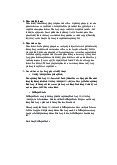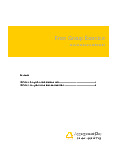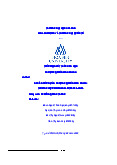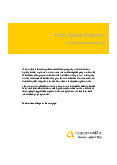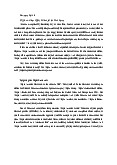
















Preview text:
BRAND MANAGEMENT FINAL EXAM
Instructor: Ms. Dang Truong Thuy Anh Member: Name ID Vu Hong Duc 2193678 Truong Dieu Tuong Van 2198309 Tran Thi Phuong Uyen 2199021 Nguyen Dinh Hieu 2180709 Ha Nhat Minh 2171166 Hoa Sen University Members of the group: Name Student ID Work Contribution mark Part A: Question 1 Vu Hong Duc 2193678 Question 2 100% Truong Dieu Tuong Part B: Question 1 2198309 Van Question 2 100% Tran Thi Phuong Part B: Question 2 2199021 Uyen Question 3 100% Part A: Question 3 Nguyen Dinh Hieu 2180709 Question 4 90% Ha Nhat Minh 2171166 Part B: Question 4 100% Tables of content I.
INTRODUCTION........................................................................................................................1 2 Hoa Sen University II.
MAIN CONTENT....................................................................................................................1
Part A: Discussion Questions:.........................................................................................................1
Question 1: With respect to positioning, explain points-of-parity (POP) and points-of-difference
(POD). Provide examples of 2 brands of your choice which you consider “failed” to achieve POP
or POD...........................................................................................................................................1
Question 2: Identify and describe the four value stages of the brand value chain..........................1 1.
Value stage – Marketing Program Investment :..................................................................1 2.
Value Stage – Customer Mindset........................................................................................2 3.
Value Stage – Market Performance.....................................................................................3 4.
Value Stage – Shareholder..................................................................................................3
Question 3: The creation of significant brand equity involves reaching the top or pinnacle of the
brand pyramid. List and briefly characterize the six components of the brand resonance pyramid.
.......................................................................................................................................................3
Question 4: Brands can be differentiated on the basis of many variables; however, four
differentiation strategies are emphasized in the text. List and briefly characterize the three
differentiation strategies.................................................................................................................4
Part B: Case Study:..........................................................................................................................4
Question 1: How would you describe the personality of the Brand? (Choose four brand
associations). Explain why you chose these attributes....................................................................4
Question 2: Describe shortly the 6 brand building blocks of Disney’s CBBE model....................6 1.
Salience..............................................................................................................................6 2.
Performance........................................................................................................................6 3.
Image..................................................................................................................................7 4.
Judgement...........................................................................................................................7 5.
Feeling................................................................................................................................7 6.
Resonance...........................................................................................................................7
Question 3: Walt Disney is now a multibrand media company: Pixar, ESPN, Miramax, Marvel,
LucasFilm, etc. Which Brand has more potential for the future? Justify your answer....................8
Question 4: Analyze the Diagram presented by FutureBrand Index: Brand story out considerably
in the comparison of brands. Why do you think so and why is important for the future?...............8 III.
CONCULSION.......................................................................................................................11 IV.
REFERENCES.......................................................................................................................12
References............................................................................................................................................12 Image Catalog
Figure 1: Disney's CBBE model...............................................................................................................6 3 Hoa Sen University
Figure 2: Loki poster...............................................................................................................................9
Figure 3: STAR WARS THE BAD BATCH POSTER.....................................................................................10
Figure 4: DISNEY LAND AT L.A...............................................................................................................10
Figure 5: RAYA AND THE LAST DRAGON POSTER..................................................................................11 4 Hoa Sen University I. INTRODUCTION
Walt Disney, more commonly known as Disney is an entertainment and multimedia
corporation founded by brothers Walt and Roy O in 1923, first known as the
Animation Studios Disney Brothers. After twice changing its name to Disney Studio
and Walt Disney Production, in 1986 it changed its name to Walt Disney and used this
name until now[ CITATION Adm201 \l 1033 ]. Disney owns a series of film
production companies and studios such as Pixar, Marvel, Lucasfilm, ... the characters,
Disney Land park, Disney Media Networks, ... The featured symbol that brings Disney
closer to the audience is Mickey Mouse, Donald Duck, animated movies,
entertainment shows, etc. In order to understand and find out why Walt Disney can
grow and succeed, the directors, managers, and employees of Walt Disney have given
come up with ideas and strategies on how to lead the Walt Disney Company to become
a great, high-value brand, well-received by customers, and become one of the largest
entertainment companies in the world at the present time. II. MAIN CONTENT Part A: Discussion Questions:
Question 1: With respect to positioning, explain points-of-parity (POP) and points-of-
difference (POD). Provide examples of 2 brands of your choice which you consider
“failed” to achieve POP or POD.
Point-of-parity (POP) are links that are not necessarily unique to a brand but may, in
fact, be shared with other brands. Point of difference (POD), on the other hand, are
benefits or attributes that consumers associate closely with a brand, rate positively, and
believe they cannot find to an extent similar to a brand compete.[ CITATION Mar \l 1033 ]
Samsung failed in POD: In 2011, Samsung surprised the world by launching a phone
with a screen size sneaking up to 5.3 inches. Customers at the time thought that it was
an oversized size for a regular phone and that the introduction at that time was
unnecessary. [ CITATION diễ20 \l 1033 ]
Dove fails in POD : Dove's "Real Beauty" campaign running for the past 15 years was
supposed to be an excellent campaign but it wasn't until the Dove team in the UK
created limited products designed like bodies of women with many different types of
shapes make them unintentionally choose products that are similar to their body shape. [ CITATION diễ20 \l 1033 ]
Question 2: Identify and describe the four value stages of the brand value chain.
The 4 stages of the brand value chain each have their own building elements. Each of
the preceding periods affects the following period and is determined by that period's
multiplier. [ CITATION htt \l 1033 ]
1. Value stage – Marketing Program Investment : 1 Hoa Sen University
Any marketing program or activity can help develop a company's brand value. From
there , the brand value chain starts from investing in marketing activities / programs ,
including many other types of investment . Besides, the level of investment will not
guarantee the success of creating brand value. At this stage, the Program Quality
coefficient will affect the conversion of brand value.
Program Multiplier - Program Quality Factor :
The four main evaluation criteria are as follows:
• Clarity : This means that communication campaigns and forms of
communication must be easy to understand and convey marketing messages to
customers . [ CITATION htt \l 1033 ]
• Relevance : The marketing program must be relevant to the customer . Identify
the reason they buy and make sure it fits their life. [ CITATION htt \l 1033 ]
• Distinctiveness: The available marketing program must be different from
competitors to help customers feel more attractive [ CITATION htt \l 1033 ]
• Consistency : The aspects of the program that have a major impact on
customers through the channels the program uses. [ CITATION htt \l 1033 ])
2. Value Stage – Customer Mindset
Choosing the right investment in the program will lead to a number of different
outcomes in relation to the client. From there, customer thinking includes what is in
their mind towards the brand: attitudes, beliefs, emotions, experiences, perceptions,
etc. To understand more deeply there is a structure. simple with 5 main factors, also
known as "5 A" [ CITATION htt \l 1033 ]
• Brand Awareness: The simplest level for customers to remember and recognize the brand.
• Brand Associations: What customers associate and associate with when thinking about the brand.
• Brand Attitudes : General judgments about the reviews and feelings created
• Brand Attachment : Attached customers have a strong sense of brand loyalty even if a bad event occurs .
• Brand Activity: Customers actively stick with the brand, introduce the brand to
people around, always hunt for promotions and new information about the brand. Customer Multiplier
There are three factors that influence the functioning of the market to create the degree
of value creation in the mind of the customer:
• Competitive advantage (Competitive Superiority): Factors that make a brand
produce goods and services better or cheaper than competitors.
• Channel and other intermediary support : Channels and partners increase sales and marketing efforts 2 Hoa Sen University
• Customer size and profile (Customer size and profile): Type of customers attracted to using the brand
3. Value Stage – Market Performance
There are 6 main ways customers react and respond to the market with their customer mindset:
• Price premiums and Price clasicity : how much customers are willing to pay for
a product for that brand and demand increases or decreases as the prices of the products go up and down .
• Market share : Promote sales by measuring the success of marketing activities.
• Expansion success : Supporting revenue from successfully expanding the brand
into categories and introducing new products
• Cost Structure : The ability to save costs for marketing activities
• Profitability : Profit received from the above 5 factors Market Multiplier
The extent to which the market performance of some brands is represented in
shareholder value depends on various contextual factors outside of the brand.
[ CITATION htt \l 1033 ]Consists of four main elements:
• Market dynamics: forces affecting consumer behavior and patterns that cause
fluctuations in supply and demand for a given product or service
• Growth potential: internal and external factors and conditions that help a brand grow
• Risk profile : Factors and conditions that can harm or inhibit the brand
• Brand contribution: That level of contribution of the brand to the company. 4. Value Stage – Shareholder
Finally, based on all available information and forecasts about the brand through 3
main indicators: Stock Price, P/E ratio and Market Caplitalization. The word financial
markets will drive arguments and judgments that influence the financial implications
of a brand. Shareholder value will be affected by market performance. [ CITATION htt \l 1033 ]
Question 3: The creation of significant brand equity involves reaching the top or
pinnacle of the brand pyramid. List and briefly characterize the six components of the brand resonance pyramid.
Salience: This is how customers look at your brand and distinguish it from others.
Create your own prominence or characteristics so that when you mention those things,
customers will immediately think of your brand (increase brand recognition)
Performance: This includes product functionality, reliability, durability and price as
well as service and customer satisfaction. It's 'it does what it says on tin territory' and
when it works well, the customer's opinion will be positive. 3 Hoa Sen University
Imagery: This is the perception of the customer towards the brand through the
experience, personal interaction or trust of the customer with the brand.
Judgments: Reviews according to the customer's personal opinion of the brand after
experiencing and interacting with the brand.
Feelings: Customer's feelings for the brand or product. Brands need to learn about joy,
self-esteem, safety for customers to stick more to the product.
Resonance: This is a close connection between the customer and the brand. It is
affected by the customer's success. Brands must ensure customers have the right
experiences to have strong brand knowledge and connection.
Question 4: Brands can be differentiated on the basis of many variables; however,
four differentiation strategies are emphasized in the text. List and briefly characterize
the three differentiation strategies
Emotional Response: Develop an emotional relationship of customers towards the
brand's products and services so that the brand has the best position and brings
superior value to the brand [ CITATION Mic \l 1033 ]
Innovation: Develop brand products or services to always create new products in a
unique and improved style in usage. Through the physical characteristics of the
product or service distributed, customers will have a different feel towards the brand's products than other brands.
Brand Presentation: The brand will present itself to the market with its own distinctive
features and uniqueness, through the use of a representative image or a mascot with
distinct humor characteristics so that customers can easily remember and shape the
perception of the brand clearly Part B: Case Study:
Question 1: How would you describe the personality of the Brand? (Choose four
brand associations). Explain why you chose these attributes.
Brand personality is understood as a set of human characteristics associated with a
brand [ CITATION 9708 \l 1033 ]. Brand personality helps brands through the
consumer's sense to connect with them, thereby developing their relationship with
consumers [ CITATION 9708 \l 1033 ],[ CITATION Fou98 \l 1033 ]
Disney's brand personality is expressed through brand associations, typically brand
image (fun and magical,...), characters (Mickey Mouse,...), amusement parks
(Disneyland,...), movies (Family movies,…). • Fun and magical
Magic is the most striking element associated with the Disney brand. When asked
about the immediate associations of the Disney brand, consumers often think of “fun”,
“princess”, “magic”,... “Magical world” is a concept full of fun and uniqueness that
leads to the brand's association to a positive image with happiness. “Magical world” is 4 Hoa Sen University
seen as a difference for Disney compared to its competitors because only Disney can
bring it to consumers. “magic”, “fun” and “happiness” are the elements that the Disney
brand wants to attach to itself through advertising and products to attach. As a result,
people will associate magic, happiness, dreams and fun with the name “Disney”. • Character: Mickey Mouse
The first images that come to mind when it comes to Disney will often be familiar
characters like Mickey Mouse, Elsa and Frozen, Pinocchio or princesses. Thanks to the
successful construction of these characters, the creation of family movies, fantasy and
the creation of great experiences for consumers at Disneyland and Disney World, after
nearly a hundred years, Disney has been able to become a successful brand with
family movies as well as fantasy films.
Disney's characters are mostly honest people who have a desire to fight evil and in the
end, good is always the winner. This does not fully represent life because life is not
always so easy and beautiful. But this represents the ideal of life and that is the life that
people are always aiming for. That's the answer to the question of why Disney is so
attached to magic and dreams. Maybe that's why Disney is loved by so many people.
Disney has built its brand identity thanks to the use of the power of character-based brand associations. • Theme Parks:
The theme park was opened by Walt Disney in 1955. Disneyland is considered a place
where “Youth relive past memories and be able to enjoy challenges as well as promises
of the future” [ CITATION Rém14 \l 1033 ]. This place has made dreams, legends
come true. Disney has given its as-its-own consumers the opportunity to enter the
world of their favorite characters. Disneyland is a place where kids can see, meet and
chat with their favorite characters. For adults, Disneyland is a place where you can
have a great experience with good memories. This is also a place where families can
go for vacations or special occasions. As Walt Disney said, “Disneyland will never be
completed. It will continue to grow as long as there is still imagination in the world”. • Family movies:
As Walt Disney said, “I don't draw cartoons for children, I draw cartoons for the
children in each of us”. That shows that Disney's movies, products, services, and
experiences are not just for kids, but for adults, and especially families. Disney always
makes family-oriented products that show they are family-friendly brands. Some of the
films Walt Disney has released about the family: Coco – The Story of a Boy Who
Dared to Stand Up to Pursue His Passion and Humanistic Meanings about Family
Love; Brave – The story of a princess playfully disputes her mother's words and she
accidentally makes her mother hit the curse, then she must find a way to help her
mother solve the curse or her mother will die, the film clearly depicts the sacred moment of motherhood;… 5 Hoa Sen University
Through these brand associations, we can see Disney's brand personality is to create
fun for everyone and be family friendly.
Question 2: Describe shortly the 6 brand building blocks of Disney’s CBBE model. Figure 1: Disney's CBBE model 1. Salience
Walt Disney once said, “I don't draw cartoons for children, I draw cartoons for
the children in each of us”. Therefore, when it comes to the Disney brand,
almost everyone regardless of status, age, gender, religion, culture or country
recognizes this brand as well as knows about Disney products. Because
everyone has a child in them. Consumer awareness of the Disney brand around
the world is well formed because Disney has approached them since childhood.
Thanks to its high brand recognition, Disney has a strong and solid foundation
in a model of building brand value based on customer perception. This makes the model more complete. 2. Performance
Disney's performance deserves to be trusted. The products, services, and
experiences offered by Disney are priced based on value so that the products are
sold at a higher rate than their competitors but in return the quality of the
product is high and customers have the opportunity to receive more valuable
rewards. Compared to its competitors, Disney has been doing better; especially
in making products, services, experiences that exceed customer expectations. 3. Image 6 Hoa Sen University
Most of the minds of consumers, Disney's image is clearly defined. When asked
about Disney's image, they said it was inspiring and youthful [ CITATION
Par13 \l 1033 ]. The phrases “Where dreams come true”, “The happiest places
on earth”, “Where magic begins” [ CITATION Par13 \l 1033 ]or the words
“Fantasy”, “Magic”, “Fun”, “Thrill” and “Popular” are considered terms used to
talk about Disney's brand image [ CITATION AuY14 \l 1033 ]. The above are
all things in the image of the brand that Disney wants to put into the minds of
customers through the release of products, services as well as interesting advertisements. 4. Judgement.
Customers appreciate and satisfied with what Disney gives them, this
satisfaction makes customers have behavior that will continue to support
Disney. Beside that, customers also evaluate brands based on reliability, quality,
and superiority. Disney customers say that the quality of the products that
Disney brings to the market has never let them down, and they believe that
Disney will always deliver high-quality products. Disney is always the first
choice when they think of entertainment programs and they comment that
Disney is a trusted brand and guarantees quality effective entertainment
energetic. Therefore, Disney is now one of the leading companies in the
entertainment category. [ CITATION Ish \l 1033 ] 5. Feeling.
Feeling means how Disney has managed to capture the emotions of its
customers and understand how they feel about the brand. Disney built-in brand
is entertainment, fun, excitement [ CITATION AuY14 \l 1033 ]. Therefore,
every product from movies to services is full of relax, entertainment, fun,
happiness, magic and emotions. Disney has built the image of its characters
based on these emotions, creating a warm, peaceful feeling like a family when
using Disney's entertainment facilities. Disney can create many positive
emotions in customers and these emotions are the link between brands and customers 6. Resonance.
To create resonance between brands and customers, Disney must build and
maintain relationships with their customers [ CITATION AuY14 \l 1033 ] .
From the very beginning Disney built the brand value pyramid and present it
for the lifetime of the consumer, hoping to bring the brand's resonance to the
consumer. Based on many different aspects such as services, experiences,
products, etc., Disney has gradually met all the needs of customers. Disney
creates positive emotional values thus making customers feel that Disney can
build any relationship with anyone. Disney creates the characters, and it's the
characters that create the brand value for Disney. It is because of the miracles
that Disney brings to customers that make customers feel the care of the brand,
so that customers will be more loyal to the brand. Since then, the brand's
resonance with customers has been achieved. According to an analytical 7 Hoa Sen University
assessment performed by Interbrand, Disney ranks second in the table when
compared to other brands in terms of brand depth assessment. [ CITATION Jor19 \l 1033 ]
Question 3: Walt Disney is now a multibrand media company: Pixar, ESPN,
Miramax, Marvel, LucasFilm, etc. Which Brand has more potential for the future? Justify your answer
As you know, Disney is now a multi-brand company, owning many subsidiaries and
many employees of that company. This makes Disney even stronger. But of all the
subsidiaries owned by Walt Disney today, which one has the most potential for the
future? That is the question many people have asked. Of course each company will
have its own direction and the potential of that company will be different from the rest,
but in my opinion the company with the most potential among Walt Disney
subsidiaries is Pixar. When think to Walt Disney, people will think of cartoon
characters, shows and cartoons for all ages, coincidentally most of Pixar's movies are
animated movies. Pixar Animation Studios, often referred to as Pixar for short. The
origins of Pixar can be traced back to when a group of talented animators and
computer scientists met at the New York Institute of Technology and began working
on computer animation projects, the goal of which was to created the world's first
computer-animated film [ CITATION Adm20 \l 1033 ]. Disney acquired Pixar in 2006
[ CITATION Thi20 \l 1033 ]. At the time of the decision to buy Pixar, Bob Iger
encountered many difficulties when he assumed the position of CEO of Disney,
besides Disney was at this time stalled and could not find a development direction.
After acquiring Pixar, Iger quickly re-established Disney and took the lead in
animation production [ CITATION Thi20 \l 1033 ]. Thus, Pixar was the savior for
Disney's revenue and development at that time. Starting from the production of
animated films and owning a large number of famous films such as Toy Story, Wall-E,
Inside Out, Monster University, Up, etc. Pixar has owned a series of famous films and
that is the potential, the bright spot of Pixar. In addition, the films produced by Pixar
that attract audiences of all ages show that Pixar's filmmaking ability is not trivial, the
content of the films that Pixar brings to customers is not only the content
entertainment, but it also has human values about family and society. In addition, the
films produced by Pixar are also nominated for an Oscar for the award for animation.
Therefore, it is not wrong to say that among the subsidiaries of Walt Disney, Pixar is
the company with the most potential in the future.
Question 4: Analyze the Diagram presented by FutureBrand Index: Brand story out
considerably in the comparison of brands. Why do you think so and why is important for the future?
As the Diagram presented by FutureBrand Index, we can easily see that the Story 2021
index outperforms the 2020 average. Walt Disney has created compelling, timeless
stories that are clearly enjoyable, and thereby deliver inspirational products to
consumers who have a love for the characters and stories created by Walt Disney. The
story attached to people's minds when it comes to Walt Disney is the image of Mickey 8 Hoa Sen University
Mouse, thereby creating products associated with this image, such as amusement
parks, souvenirs. concept, entertainment program, toys, clothes... Even today, Mickey
Mouse is still the inspiration for many Disney Walt Disney stories. They exploited it
and created many other compelling characters and stories that have a unified, clear
layout, attractive, engaging to further develop their brand. The evidence shows that
many characters are created in their amusement parks such as: Maleficent, Peter Pan,
Snow White, ... and most recently Raya - the Asian princess - has created a storm fever
in 2021, the 8th highest grossing movie in 2021. Due to the impact of the epidemic in
2021, Walt Disney's revenue is still increasing exponentially thanks to streaming
(Disney+, ESPN+, HULU...) and the return of amusement parks. Specifically, Disney's
sales reached $17 billion, up 45% year-on-year and slightly higher than Wall Street's
$16.8 billion forecast previously.The company's profit came in at $995 million, up
sharply from a loss of $4.8 billion recorded in the same period last year. [ CITATION Han21 \l 1033 ]
In 2021, due to the impact of the epidemic, many amusement parks have not been
opened in some countries, so the streaming services that bring Disney revenue are
extremely many, Notably, Disney+ channel subscriptions in the quarter more than
doubled year-on-year to 116 million. Some outstanding series with many views such
as: Loki, WandaVision, The Mighty Ducks: The Game Changers, Star Wars: The Bad
Batch... [ CITATION SEI22 \l 1033 ] Figure 2: Loki poster 9 Hoa Sen University
Figure 3: STAR WARS THE BAD BATCH POSTER
After months of closure due to Covid 19, Disney Land parks have gradually reopened
to welcome guests in 2021, however, the number of visitors is still limited, but the
number of registrations at the park is extremely high. This also shows that Disney's
influence through the pandemic is still interested by customers in this brand and their
trust in Disney, customers are still willing to return to the park when they meet the conditions. Figure 4: DISNEY LAND AT L.A 10 Hoa Sen University
Figure 5: RAYA AND THE LAST DRAGON POSTER
The characters and stories that Walt Disney built are always associated with cheerful
colors, cute and memorable images, associated with many people's childhoods, aimed
at children, but not children. The stories that Disney builds always convey meaningful
messages about love, friendship, family affection and countless other good meanings,
aimed at many customers of different ages, Anyone can receive the message that
Disney sends in the story they create
Brand story will be one of the key elements of Walt Disney as it will motivate their
creators to create many new stories and characters and thereby create products related
to the story or that character. And from there, a coherent, unified and attractive story
series has been built. This keeps users interested in your stories in the future and builds
trust between your business and customers.
In the future, when the economy has stabilized again, Disney will surely have more
competitors in many aspects from entertainment programs, amusement parks,... With
the construction style brand through stories, surely Disney will continue to grow
stronger, because the stories they create are always welcomed and supported by many
people, customers always have a strong belief in their brand. The stories that Disney
creates always have an engaging, attractive, humanistic plot, many meaningful
messages, but always have cheerful colors and colorful images that are easily receptive. III. CONCULSION
Walt Disney is a big company, a strong competitor in the entertainment market, but it
is certainly not invincible[ CITATION Jor19 \l 1033 ]. Although Disney's competitors
are quite successful, Disney is always mentioned first and maintains its throne, which
is reflected in the revenue, profit, and existing assets of Walt Disney. Walt Disney
provides all the needs and expectations of customers, they know what customers need
in their brand, from which they develop their brand partly based on customer needs.
Give your customers everything and let Disney customers immerse themselves in the
magic of the brand. With the dominance of the entertainment market by Walt Disney 11 Hoa Sen University
(owning a series of brands such as Marvel, Pixar, Miramax, ..), Disney owns a huge
treasure of ready-to-use and marketable content. This ensures that Walt Disney
maintains the integrity of its brand image in this large entertainment market. In short,
Walt Disney is a great gem and will continue to develop the Walt Disney brand in the future. IV. REFERENCES References
(2020). Retrieved from https://trip14.com/moi-thu-ban-can-biet-ve-xuong-phim-pixar_evdlbpjq
Aaker, J. L. (1997, 08 01). Dimensions of brand personality. Retrieved from journals.sagepub:
https://journals.sagepub.com/doi/abs/10.1177/002224379703400304
Admin. (2020). Walt Disney – Công ty gi i trí hành đầầu thếế gi ả
ới. Retrieved from http://nienlich.vn/tin-
tuc/nien-lich-thuong-hieu/walt-disney-cong-ty-giai-tri-hanh-dau-the-gioi#:~:text=C
%C3%B4ng%20ty%20Walt%20Disney%2C%20th%C6%B0%E1%BB%9Dng,em%20Walt%20v %C3%A0%20Roy%20O.
Admin. (n.d.). Brand Resonance. Retrieved from https://businessjargons.com/brand-resonance.html?
fbclid=IwAR18VasCfGG8CXWwJCHsr1IqbnFSiow61LWQtfKJkhHaYaBjTatDgPVatCM
Administrator. (2020). M i thọ b n cầần biếết vếầ x ứ ạ
ưở ng phim Pixar. Retrieved from
https://trip14.com/moi-thu-ban-can-biet-ve-xuong-phim-pixar_evdlbpjq
Consulting, D. (2020, 11 27). Retrieved from mô hình quản tr th ị ươ ng hiệ u:
https://dtmconsulting.vn/mo-hinh-chuoi-gia-tri-thuong-hieu/
Fournier, S. (1998, 03 01). Consumers and their brands: Developing relationship theory in consumer
research. Retrieved from academic.oup : https://academic.oup.com/jcr/article- abstract/24/4/343/1797962
MCQ, M. (n.d.). Retrieved from https://marketingmcq.blogspot.com/2019/04/with-respect-to- positioning-explain.html
Michael, P. (n.d.). 5 Strategies to Drive Brand Differentiation. Retrieved from
https://radiusinsights.com/blog/5-strategies-to-drive-brand-differentiation/?
fbclid=IwAR15JPwAMl7kgt0OJ08XqOQX7B7-8q9obrYRz85a7tBpujKWPH9vpQceUK0
nghi p, d. đ. (2020, 05 04). R ệ
etrieved from 20 chiếến dị ch marketing thảm họ a và bài họ c rút ra:
https://diendandoanhnghiep.vn/20-chien-dich-marketing-tham-hoa-va-bai-hoc-rut-ra-phan- 1-168709.html
Nguyen, H. (2021). Doanh thu c a hãng Disney v ủ t d
ượ kiếến bầết chầếp t ự
ác động củ a đại dị ch .
Retrieved from VietNam+: https://www.vietnamplus.vn/doanh-thu-cua-hang-disney-vuot-du-
kien-bat-chap-tac-dong-cua-dai-dich/733509.vnp
Nhan, T. (2020). Đằầng sau quyếết đ nh mua l ị i Pixar c ạ ủ a Disney. Retrieved from
https://zingnews.vn/dang-sau-quyet-dinh-mua-lai-pixar-cua-disney-post1164826.html
Parekh, I. (2013). Beyond the Castle: An Analysis of the Strategic. Retrieved from
https://www.slideshare.net/ishanparekh/brand-management-walt-disney-case-study 12 Hoa Sen University
Parekh, I. (2013, 08 06). slideshare.net. Retrieved from Brand Management - Walt Disney (Case
Study): https://www.slideshare.net/ishanparekh/brand-management-walt-disney-case-study
Rémy Borello, T. J.-E. (2014, 09 01). STRATEGIC MARKETING - Walt Disney company’s KPI branding
elements. Retrieved from slideshare.net: https://www.slideshare.net/AMortellier/disney- case-study-esc-clermont
SEIZEDIX. (2022). Top 10 b phim đáng xem nhầết tr ộ
ến Disney+ trong nằm 2021. Retrieved from
dienanh.net: https://www.dienanh.net/top-10-phim-dang-xem-nhat-tren-disney-trong-nam- 2021-40779.html
Sturgill, J. (2019). Brand Management - Walt Disney case study. Retrieved from
https://dc.etsu.edu/cgi/viewcontent.cgi?article=1554&context=honors
Tai, A. Y. (2014, 10 23). Assignment 1 - disney - final. Retrieved from academia :
https://www.academia.edu/9469356/Assignment_1_disney_final 13
